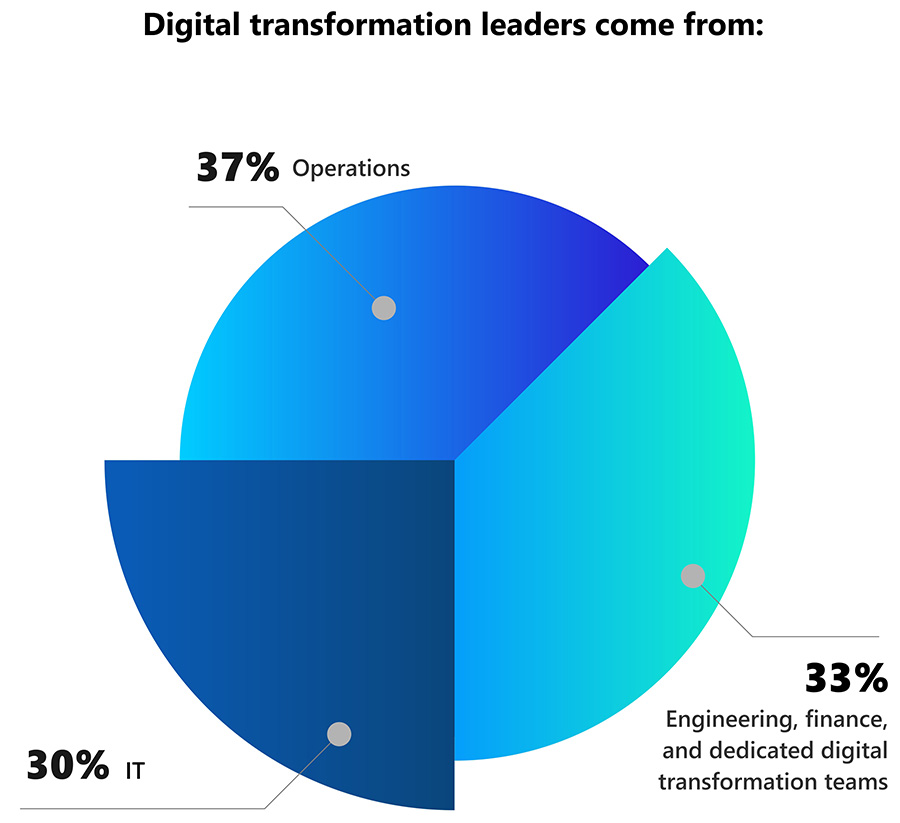
According to an IDC whitepaper (“The Digitization of the World – From Edge to Core”), two-thirds of global CEOs reported an intent to move to a digital-first focus. Given how digital technology can transform most, if not all, aspects of work, its potential and implications for HR are in no doubt! Getting it done – that is the true obstacle and the final goal.
“The State Of Manufacturing: CEO Insights” report from Oden Technologies shows that 86 percent of manufacturers have appointed digital transformation leaders in the following domains:

Notably, HR does not appear to have a sizable presence.
But this is counter-intuitive, as digital transformation at its root is about people. The affected roles and departments are not just tech-intensive ones, as this transformation helps people act faster and decide better. Wider perspectives make for better implementation and training plans toward a digitally transformed state.
HR uses transformation programs to facilitate the transition to and deployment of new technologies. The transformation however also needs innovations in approaches, people, and processes. The key ingredient is an innovative mindset, helping HR to unearth faults in processes and challenges faced by users, and determine the technologies that offer solutions.
Digital transformation is not just for goods and services produced by an organization. It affects how the organization treats its workforce and how HR interacts with and manages the workforce. As consumers for the services offered by the HR department, employees will also leverage the digital experiences, using them in their personal lives to handle their concerns.
From an analog, traditional practice, HR must undergo a marked change in appearance, nature, and form to become digitalized. And this transformation must spread through HR initiatives across the organization! The process should proceed in the following order:
As people are the ones who will bring about the admittedly complicated outcome, HR needs to have a more active involvement. This makes for the ultimate HR challenge in managing change, as it affects all departments, levels, processes, and stakeholders of an organization, as well as the partner network and supply chain in some cases. The effect is broadly in twin dimensions:
Properly designing and delivering the employee experience is critical to the success of the digital transformation initiative. To this end, HR professionals can combine the power of technology with the human element such that new insights and adapted process bring value growth for the company.
Successful digital transformation requires a strong showing in four interrelated domains: technology, data, process, and organizational capability for change. Here is a look at the talent implications for each:
Multigenerational workforces in a rapidly changing world further pushed by glocalization make it hard to understand and plan for these talent demands. In these disruptive and transformative times, optimal talent acquisition and development ensure profitable and sustainable operations.
Successful digital transformation by HR must achieve the following:
To properly shape the future of work and the future employees in this digitally transformed era, here are five trends HR must note:
From a state where people need to work, digital transformation is taking the workplace to a position where they want to work. And therein is the conundrum for talent management. Change the needs to wants, and you bring and keep top talent within your folds in the new digitalized era!

CredBadge™ is a proprietary, secure, digital badging platform that provides for seamless authentication and verification of credentials across digital media worldwide.
CredBadge™ powered credentials ensure that professionals can showcase and verify their qualifications and credentials across all digital platforms, and at any time, across the planet.

Please enter the License Number/Unique Credential Code of the certificant. Results will be displayed if the person holds an active credential from TMI.